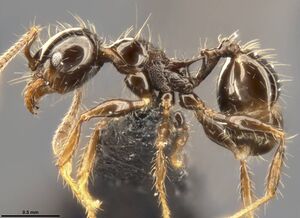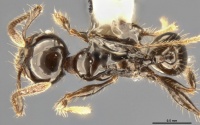Pheidole simonsi
| Pheidole simonsi | |
|---|---|

| |
| Scientific classification | |
| Kingdom: | Animalia |
| Phylum: | Arthropoda |
| Class: | Insecta |
| Order: | Hymenoptera |
| Family: | Formicidae |
| Subfamily: | Myrmicinae |
| Tribe: | Attini |
| Genus: | Pheidole |
| Species: | P. simonsi |
| Binomial name | |
| Pheidole simonsi Wilson, 2003 | |
| Synonyms | |
| |
J. T. Longino (1997): “This species occurs in mature moist to wet forest. It nests in the soil, with a main nest chamber about 10 cm deep. When workers excavate soil from the nest, they often form a characteristic flat arena around the nest entrance, surrounded by a palisade-like ring of soil. Their nests contain seed caches, and the majors have massive heads, which suggest granivory as a major component of the diet. They are not restricted to granivory, however, since workers readily recruit to baits of several kinds.” I found simonsi nests of the kind just described in bare stretches of clay-soil paths through mature forest at the La Selva Biological Station.
The nest of the type colony of Pheidole gangamon was in black clayey soil in the middle of a path through degraded lowland rainforest. The single entrance hole was surrounded by a narrow ring of excavated earth. Major workers were scarce. (Wilson 2003)
Identification
See the description in the nomenclature section.
Keys including this Species
Distribution
Both Atlantic and Pacific slopes of Costa Rica to 800 m (Longino 1997).
Latitudinal Distribution Pattern
Latitudinal Range: 23.050833° to 8.407045°.
| North Temperate |
North Subtropical |
Tropical | South Subtropical |
South Temperate |
- Source: AntMaps
Distribution based on Regional Taxon Lists
Neotropical Region: Belize, Costa Rica (type locality), El Salvador, Guatemala, Honduras, Mexico (type locality), Nicaragua, Panama (type locality).
Distribution based on AntMaps
Distribution based on AntWeb specimens
Check data from AntWeb
Countries Occupied
| Number of countries occupied by this species based on AntWiki Regional Taxon Lists. In general, fewer countries occupied indicates a narrower range, while more countries indicates a more widespread species. |

|
Estimated Abundance
| Relative abundance based on number of AntMaps records per species (this species within the purple bar). Fewer records (to the left) indicates a less abundant/encountered species while more records (to the right) indicates more abundant/encountered species. |

|
Biology
Castes
Worker
Minor
Images from AntWeb
  
| |
| Not Provided. Worker. Specimen code casent0283444. Photographer Adam Lazarus, uploaded by California Academy of Sciences. | Owned by EPEC. |
  
| |
| Not Provided. Worker. Specimen code casent0283445. Photographer Adam Lazarus, uploaded by California Academy of Sciences. | Owned by EPEC. |
Nomenclature
The following information is derived from Barry Bolton's Online Catalogue of the Ants of the World.
- simonsi. Pheidole simonsi Wilson, 2003: 630, figs. (s.w.) COSTA RICA.
- Senior synonym of arctos: Longino, 2019: 59.
- Senior synonym of gangamon: Longino, 2019: 59.
- Senior synonym of thrasys: Longino, 2019: 59.
- arctos. Pheidole arctos Wilson, 2003: 623, figs. (s.w.) MEXICO.
- Junior synonym of simonsi: Longino, 2019: 59.
- gangamon. Pheidole gangamon Wilson, 2003: 626, figs. (s.w.) MEXICO.
- Junior synonym of simonsi: Longino, 2019: 59.
- thrasys. Pheidole thrasys Wilson, 2003: 631, figs. (w.) PANAMA.
- Junior synonym of simonsi: Longino, 2019: 59.
Unless otherwise noted the text for the remainder of this section is reported from the publication that includes the original description.
Taxonomic Notes
Longino (2019): Wilson (2003) named four species from Mexico and Central America that are all extremely similar and together form a very distinctive group with no similar species in the region. They are P. arctos from Tamaulipas, Mexico; P. gangamon from Veracruz, Mexico; P. simonsi from Costa Rica; and P. thrasys from Panama. The four taxa together clearly form a clade that is common in lowland wet forest throughout Central America and southern Mexico, exhibiting uniform habitat preference, behavior, and nesting habits. Minor workers are nearly uniform across the range. Major workers show some geographic variation, with southern versions having longer, thinner propodeal spines and longer dorsal pilosity. Specimens from Guatemala northward have shorter propodeal spines and are more bristly-looking, with shorter dorsal pilosity. DNA barcoding data are all from the southern populations and show two clusters. One has numerous Panama specimens and one specimen from Guanacaste, Costa Rica. Another cluster has numerous specimens from Guanacaste and many specimens from the Atlantic lowlands of Costa Rica, Nicaragua, and southern Honduras. Cryptic species may emerge with further study, but at present there are no known morphological discontinuities at any one site or anywhere across the range of the clade.
Description
DIAGNOSIS Distinguished within Pheidole generally by the following set of character states.
Major: scrobes extend halfway up the head capsule; entire rear third of head dorsum, including occiput, rugoreticulate, but central third devoid of any sculpturing except scattered foveolae; postpetiolar node rugoreticulate; ventral profile of first gastral tergite lined with dense semierect hairs of uniform length.
Minor: propodeal spines very long, thin, and needle-like; body almost completely devoid of any sculpturing, instead smooth and shiny everywhere. The minor is very close to ‘’Pheidole thrasys’’, differing in the slightly broader occiput, rudimentary nuchal collar, and brown tarsi.
MEASUREMENTS (mm) Holotype major: HW 1.34, HL 1.60, SL 0.58, EL 0.14, PW 0.78. Paratype minor: HW 0.66, HL 0.70, SL 0.66, EL 0.14, PW 0.44.
COLOR Major: head and mesosoma medium reddish brown, waist and mandibles plain dark brown, gaster black, antennae and legs medium brown.
Minor: head, waist, gaster, and femora dark, almost blackish brown; mandibles, mesosoma, and rest of leg segments medium brown.
Pheidole arctos
DIAGNOSIS Close to Pheidole gangamon, also of Mexico, and probably also to Pheidole epetrion and Pheidole thrasys, but distinguished from these and other members of the scrobifera group by the following combination of traits.
Major: rear one-fourth of dorsal head surface, rear one-half of the lateral head surfaces, and area between the eye and frontal lobes rugoreticulate; anterior half of the frontal lobes carinulate; entire central half of the dorsal head surface foveolate only; all of promesonotal and postpetiolar dorsa carinulate to rugoreticulate; anterior central strip of first gastral tergite longitudinally striate; humerus composing a very large lobe that projects high above the mesonotal convexity; posterior half of dorsal head profile weakly concave.
Minor: the two humeri conulate, the tip of each bearing very long hairs; head and prothorax entirely smooth and shiny.
MEASUREMENTS (mm) Holotype major: HW 1.28, HL 1.60, SL 0.62, EL 0.18, PW 0.82. Paratype minor: HW 0.62, HL 0.64, SL 0.60, EL 0.12, PW 0.42.
COLOR Major and minor: body dark brown, appendages medium brown, tarsi yellow.
Pheidole gangamon
DIAGNOSIS Close to Pheidole arctos, but distinguishable from it (and other members of the scrobifera group) by the pattern of sculpturing and details of body form in the major, and in the unusually long, needle-like propodeal spines and piligerous cornicles of the humeri, also as shown.
MEASUREMENTS (mm) Holotype major: HW 1.24, HL 1.54, SL 0.58, EL 0.16, PW 0.72. Paratype minor: HW 0.58, HL 0.58, SL 0.58, EL 0.12, PW 0.38.
COLOR Major: body and appendages medium reddish brown; gaster dark brown.
Minor: light brown.
Pheidole thrasys
DIAGNOSIS A member of the scrobifera group known only from the minor, close to Pheidole arctos of northeastern Mexico and Pheidole epetrion of Ecuador, differing in the narrowed occiput, possession of a nuchal collar, and completely smooth and shiny mesonotum; also close to Pheidole simonsi, differing in its narrower occiput, well-developed nuchal collar, and yellow tarsi.
MEASUREMENTS (mm) Holotype minor: HW 0.60, HL 0.62, SL 0.60, EL 0.12, PW 0.40.
COLOR Minor: body dark brown, tarsi yellow, rest of appendages light yellow.
Pheidole simonsi. Upper: holotype, major. Lower: paratype, minor. Scale bars = 1 mm.
Pheidole gangamon. Upper: holotype, major. Lower: paratype, minor. Scale bars = 1 mm.
Pheidole arctos. Upper: holotype, major. Lower: paratype, minor. Scale bars = 1 mm.
Pheidole thrasys. Holotype, minor. Scale bars = 1 mm.
Type Material
Pheidole simonsi: COSTA RICA: La Selva Biological Station, near Puerto Viejo, Heredia, col. Stefan Cover. Museum of Comparative Zoology
Pheidole arctos: MEXICO: Gomez Fariás, Tamaulipas, 400–600 m, col. Cornell University Mexico Field Party, 1964. Museum of Comparative Zoology
Pheidole gangamon: MEXICO: Pueblo Nuevo, near Tetzonapa, col. E. O. Wilson. Museum of Comparative Zoology
Pheidole thrasys: PANAMA: Barro Colorado Island, col. William L. Brown and Elwood S. McCluskey. Museum of Comparative Zoology
Etymology
Pheidole simonsi: Named in honor of my friend, the late Howard Simon, former managing editor of the Washington Post, Curator of the Nieman Fellows, and fellow entomologist.
Pheidole arctos: Gr arctos, bear, alluding to the large size and rough, shaggy appearance of the major.
Pheidole gangamon: Gr gangamon, a small, round net, referring to the occipital rugoreticulum of the major.
Pheidole thrasys: Gr thrasys, bold, courageous.
References
- Wilson, E. O. 2003. Pheidole in the New World: A dominant, hyperdiverse ant genus. Harvard University Press, Cambridge, MA. (page 630, fig. major, minor described)
- Longino, J.T. 2019. Pheidole (Hymenoptera, Formicidae) of Middle American Wet Forest. Zootaxa 4599: 1–126 (DOI 10.11646/zootaxa.4599.1.1).
- Vázquez-Franco, C.M., Morrone, J.J. 2022. The genus Pheidole (Hymenoptera: Formicidae: Myrmicinae) in Puebla, Mexico. Revista Mexicana de Biodiversidad 93: e933820 (doi:10.22201/ib.20078706e.2022.93.3820).
References based on Global Ant Biodiversity Informatics
- Ahuatzin D. A., E. J. Corro, A. Aguirre Jaimes, J. E. Valenzuela Gonzalez, R. Machado Feitosa, M. Cezar Ribeiro, J. Carlos Lopez Acosta, R. Coates, W. Dattilo. 2019. Forest cover drives leaf litter ant diversity in primary rainforest remnants within human-modified tropical landscapes. Biodiversity and Conservation 28(5): 1091-1107.
- Basset Y., L. Cizek, P. Cuenoud, R. K. Didham, F. Guilhaumon, O. Missa, V. Novotny, F. Odegaards, T. Roslin, J. Schmidl et al. 2012. Arthropod diversity in a tropical forest. Science 338(6113): 1481-1484.
- Dattilo W. et al. 2019. MEXICO ANTS: incidence and abundance along the Nearctic-Neotropical interface. Ecology https://doi.org/10.1002/ecy.2944
- Donoso D. A. 2014. Assembly mechanisms shaping tropical litter ant communities. Ecography 37 doi: 10.1111/j.1600-0587.2013.00253.x
- Fernández, F. and S. Sendoya. 2004. Lista de las hormigas neotropicales. Biota Colombiana Volume 5, Number 1.
- Longino J. T. 2019. Pheidole (Hymenoptera, Formicidae) of Middle American wet forest. Zootaxa 4599: 1-126
- Longino J. T. L., and M. G. Branstetter. 2018. The truncated bell: an enigmatic but pervasive elevational diversity pattern in Middle American ants. Ecography 41: 1-12.
- Longino J. T., and R. K. Colwell. 2011. Density compensation, species composition, and richness of ants on a neotropical elevational gradient. Ecosphere 2(3): 16pp.
- Longino J. et al. ADMAC project. Accessed on March 24th 2017 at https://sites.google.com/site/admacsite/
- Sandoval V. E., and G. Zambrano. 2007. Catálogo de las hormigas presentes en el Museo de Historia Natural de la Universidad del Cauca. Taller Editorial de la Universidad del Cauca, Popayán. 60 pp.
- Smith M. A., W. Hallwachs, D. H. Janzen. 2014. Diversity and phylogenetic community structure of ants along a Costa Rican elevational gradient. Ecography 37(8): 720-731.
- Wilson, E.O. 2003. Pheidole in the New World: A Dominant, Hyperdiverse Genus. Harvard University Press





